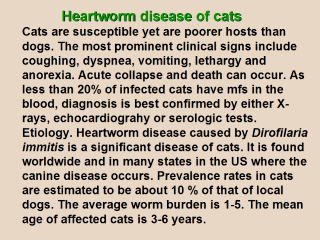| front |1 |2 |3 |4 |5 |6 |7 |8 |9 |10 |11 |12 |13 |14 |15 |16 |17 |18 |19 |20 |21 |22 |23 |24 |25 |26 |27 |28 |review |
 |
Life
Cycle. Cats like dogs are infected by mosquitoes.
The cat is a deadend host, because there are not usually enough adult worms
to breed and produce mfs.
Larvas migrate to the heart and pulmonary arteries where they mature. Mismigration of mfs to sites like the brain occurs occasionally. The lesions of endarteritis caused by adult heartworms are similar to those seen in the dog. The immune response which appears to be much stronger in the cat than in the dog may be sufficient in many cats to destroy the invading mfs and thus prevent spreading infection. Clinical Features. Clinical signs are absent to severe. A small worm burden can cause chronic vomiting, coughing, dyspnea, respiratory failure and weight loss. The infection is sometimes confused with bronchial asthma. Six to 10 worms may cause right side heart failure. When the disease is acute there may be convulsions, diarrhea, tachycardia and collapse. Diagnosis - This is sometimes more difficult in the cat because of the absence of mfs. ELISA procedures are available for detection of antigen and antibodies. As in the dog radiography and echocardiography are useful. Treatment. The use of an adultacide such as thiacetarsamide IV may be accompanied by pulmonary thromboembolism and a mortality of 20-30 %. Various drugs are used for supportive therapy including prednisone or prednisolone to reduce inflamation, theophyline for bronchial dilation and inflamation reduction and lifesaving supplemental oxygen.Control. Cats are usually tested for antigens before beginning prophylactic medication which involves monthly administration of ivermectin in tablet form to cats 6 weeks or older, or selamectin (Revolution) applied topically. These and several other drugs kill the larvas of D. immitis. |